Inside your sun-baked shepherd's pie, you'll find layers of savory ground lamb or beef mixed with Worcestershire sauce, tomato paste, and fresh Mediterranean herbs like thyme, rosemary, and parsley. The meat base combines with tender vegetables including peas, carrots, corn, and mushrooms, all bound together in a rich gravy made from stock and flour. Topping it all is a golden-brown crown of creamy mashed potatoes, seasoned with garlic, butter, and cream, then baked to perfection in a solar oven at temperatures between 260-300°F. There's much more to discover about this sustainable twist on a classic comfort dish.
Classic Meat Base Essentials

Starting with the essential meat base, you'll need several key ingredients to create the hearty foundation of a traditional shepherd's pie.
Begin with high-quality ground meat – either lamb for authentic shepherd's pie or beef for a cottage pie variation. You'll also want olive oil or clarified butter to start your base, along with finely chopped onions and minced garlic cloves.
To develop rich flavors, you'll incorporate Worcestershire sauce, tomato paste, and your choice of fresh herbs like parsley, rosemary, and thyme.
You'll need all-purpose flour to thicken your sauce, plus beef or chicken stock to create the perfect consistency. Don't forget to season with salt and pepper to enhance all the flavors.
For added depth and nutrition, you'll want to include frozen vegetables like peas, carrots, and corn. You can also add fresh mushrooms for an earthy note and diced carrots for extra texture.
If you're looking to create an even more complex flavor profile, you'll want to add a splash of red wine. Remember to keep the mixture moist with sufficient gravy or broth as it cooks. The dish is particularly popular during St. Patrick's Day celebrations when traditional Irish recipes take center stage.
Fresh Garden Spice Blend
Elevating your shepherd's pie requires a carefully crafted fresh garden spice blend that balances aromatic herbs and savory seasonings.
You'll want to start with classic Mediterranean herbs like basil and oregano, which provide sweet and earthy notes, while fresh parsley adds a bright, green flavor that cuts through the richness of the meat. Creating this blend at home is more cost-effective than buying pre-made spice mixes at the store.
For depth and complexity, include thyme and rosemary – these herbs aren't just flavorful; they're packed with anti-inflammatory properties and can boost your metabolism.
You'll need to complement these herbs with minced garlic and a careful measure of red pepper flakes for heat. Don't forget to add freshly cracked black pepper and either sea salt or Himalayan salt to enhance the overall taste profile.
To prepare your blend, you can use a food processor to combine the ingredients uniformly. If you're working with fresh herbs, dry them gently before mixing.
Store your finished blend in an airtight container – it'll keep for several months when properly stored.
For extra depth, consider incorporating finely grated parmesan, which adds a savory umami note that perfectly complements the traditional shepherd's pie flavors.
Perfect Potato Topping Secrets

A cloud-like potato topping transforms an ordinary shepherd's pie into a masterpiece of comfort food.
You'll want to start with russet potatoes, peeled and cut into uniform 1-inch cubes, then boiled until they're fork-tender. After draining, let them steam dry to remove excess moisture – this vital step guarantees your mash won't become watery. Avoid over-mashing your potatoes to maintain their light, airy consistency and prevent them from becoming gluey.
The secret to achieving that dreamy, fluffy texture lies in your choice of dairy ingredients. You'll create the perfect blend by combining butter, cream, and sour cream, which adds a subtle tanginess while contributing to the overall smoothness.
Don't forget to season with garlic powder, salt, and pepper for that perfect savory balance.
For the ultimate potato topping, follow these essential steps:
- Mash your potatoes with melted butter first, then gradually incorporate the cream mixture.
- Add a generous sprinkle of parmesan cheese for extra depth and a slightly nutty flavor.
- Create distinctive ridges on the surface with a fork before baking – these will brown beautifully and add appealing texture.
Before serving, drizzle with melted butter and garnish with fresh thyme leaves for a professional finish.
Sun-Powered Cooking Setup
You'll need to monitor your solar oven's temperature closely, aiming for 260-300°F and checking every 10 minutes when cooking your Shepherd's Pie.
Set up your box-style solar cooker by lining it with aluminum foil for reflection and black construction paper for heat absorption, then cover with multiple layers of plastic wrap to create an effective greenhouse effect.
Position your oven in full sunlight between 11 am and 3 pm, adjusting its alignment every 15 minutes to maintain ideal heating for your dish.
Solar Oven Temperature Control
Successful solar oven cooking depends heavily on maintaining proper temperature control throughout the cooking process.
You'll need to verify your solar oven reaches at least 178°F before you start cooking, though higher temperatures will accelerate your cooking time. Most basic DIY solar ovens can achieve about 200°F, while advanced models like the Sun Oven can reach up to 260°F when properly positioned.
To maintain ideal cooking temperatures, you'll need to:
- Position your oven by standing behind it and aligning it so the shadow falls directly behind.
- Adjust the oven's position every 15-30 minutes to follow the sun's movement.
- Monitor internal temperature regularly, especially during preheating (25-30 minutes).
You'll get the best results between 11am and 3pm when the sun is highest.
Weather conditions will greatly impact your oven's performance, so plan your cooking on clear, sunny days. If you notice temperatures dropping, check for proper alignment and minimize any shadows inside the cooker.
Don't forget to use oven mitts when handling hot components, and keep the glass door clean for maximum heat efficiency.
Box Style Setup Guide
Building a box-style solar cooker requires careful attention to four essential components: the base structure, insulation, window cover, and reflective surfaces.
You'll need to start with a box that has a lid and three sides, then thoroughly clean it to remove any contaminants. Line the bottom with black paper to create an effective heat sink, and attach aluminum foil to the box flap for sunlight reflection.
For proper insulation, you'll want to add cotton padding or similar materials throughout the box, making sure it's evenly distributed. Cover the bottom with black construction paper and seal any gaps where heat might escape.
The window setup is vital – you'll need to create a clear cover using plastic wrap or glass that functions like a greenhouse roof, trapping heat while letting sunlight in.
Finally, you'll need to position your reflective surfaces correctly. Use aluminum foil to direct sunlight onto your food, and don't forget to include a cooking rack positioned at least two inches above the surface.
As you cook, you'll need to adjust the reflector's position to track the sun's movement and maintain consistent temperatures.
Layering Your Solar Pie

The perfect shepherd's pie relies on careful layering of ingredients to create distinct, flavorful sections.
You'll start by coating your solar-safe pan with melted butter, followed by a well-seasoned layer of cooked ground meat. For best results, use lean ground beef or lamb mixed with sautéed onions and your choice of diced vegetables.
Next, you'll create your vegetable layer using a combination of corn and complementary ingredients.
Here's what you can include:
- Frozen corn (pre-cooked) or canned corn for convenience
- Creamed corn for added richness and texture
- Additional vegetables like mushrooms, zucchini, or baby spinach
The final layer consists of smooth, seasoned mashed potatoes.
You can opt for traditional potatoes mixed with cream and butter, or try mashed cauliflower for a lighter alternative. Season your potato layer with salt, pepper, and paprika for extra flavor.
Let your meat mixture cool slightly and reduce to a gravy-like consistency before adding the potato layer.
This prevents sogginess and guarantees distinct layers in your solar-cooked shepherd's pie. For individual portions, consider using smaller, oven-safe ramekins.
Temperature and Timing Tips
You'll want to preheat your oven to 400°F (200°C) and guarantee it's fully heated before sliding in your shepherd's pie.
Watch for hot spots in your oven, as they can cause uneven browning and affect the overall doneness of your dish.
To achieve that perfect golden-brown crust, bake for 25-30 minutes and consider a quick 1-2 minute broil at the end if needed.
Ideal Preheating Guide Times
Proper preheating temperatures and timing make all the difference when reheating shepherd's pie. When using a conventional oven, you'll want to set it to 350°F (175°C) and allow 30-40 minutes for thorough heating.
Remember to cover with foil initially, then remove it for the final 10 minutes to achieve that perfectly crispy top.
If you're using a toaster oven, you'll find it's ideal for single servings. The same 350°F temperature applies, but you'll only need 15-20 minutes to get your portion piping hot.
For stovetop reheating, medium heat for 10-15 minutes works best while keeping the pan covered.
- Conventional Oven: Preheat to 350°F
- Cover with foil: 20-30 minutes
- Uncovered: Final 10 minutes
- Toaster Oven: Preheat to 350°F
- Total time: 15-20 minutes
- No foil required
- Stovetop Method:
- Medium heat setting
- Cover pan: 10-15 minutes
- Stir occasionally
The air fryer offers quick results with excellent crisping, while the microwave provides convenience but won't achieve the same crispy texture as other methods.
Hot Spots Matter Most
Inside your shepherd's pie, hot spots can make or break the final result. You'll need to maintain a consistent temperature between 375-400°F to guarantee even cooking throughout your dish.
Keep in mind that the internal temperature must reach 165°F for food safety, while avoiding burnt patches on your potato topping.
When you're layering your ingredients, distribute them evenly to prevent temperature irregularities. Start with your meat filling, add vegetables, and top with mashed potatoes, making sure to seal the edges completely.
You'll notice proper cooking when the potatoes turn slightly golden and your filling bubbles after 25-30 minutes of baking.
If you're working with a frozen pie, you'll need about an hour of baking time. For reheating, you've got options: use your oven at 350°F for 30-40 minutes, a toaster oven for 15-20 minutes, or your stovetop for 10-15 minutes.
Consider your ingredients' moisture content when setting temperatures – liquid-heavy mixtures may need lower heat, while solid ingredients can handle higher temperatures.
Don't forget to let your pie rest for 10-20 minutes before serving to guarantee the layers set properly.
Perfect Golden-Brown Crust Tips
For the perfect golden-brown crust on your shepherd's pie, mastering temperature control and timing is essential. Set your oven between 375-400°F (190-200°C) for best results, and remember that you'll need 20-40 minutes of baking time, depending on your recipe.
If you're working with a frozen pie, adjust to 160C/fan 140C/gas 3 and extend the cooking time to 60-80 minutes.
To achieve that irresistible golden crust, you'll want to:
- Brush the potato topping with beaten egg before baking
- Create crisscross patterns using a fork to form crispy ridges
- Finish under the broiler for 2-3 minutes if needed
Don't forget to let your pie rest for 5-15 minutes after baking, allowing the layers to settle properly.
For the richest, most golden crust, incorporate butter and cream into your mashed potatoes, and consider adding an egg yolk for extra richness.
You'll know your pie is ready when the internal temperature reaches 165°F (74°C) – check by inserting a fork to verify the metal comes out hot, indicating the meat is thoroughly heated.
Alternative Toppings Worth Trying

Transform your traditional Shepherd's Pie by exploring these exciting topping alternatives that go beyond standard mashed potatoes. You'll find healthier options and unique flavor combinations that'll make your dish stand out.
Try a cauliflower and potato mash blend to reduce carbs while maintaining the creamy texture you love. Mix in sharp cheddar cheese and Greek yogurt, using olive oil instead of butter for a healthier spin.
For an even lower-carb option, create a pure cauliflower mash with butter and cream, topped with melted mozzarella. Just make sure you've drained the cauliflower thoroughly to avoid a watery consistency.
If you're craving an indulgent cheesy topping, combine russet or Yukon gold potatoes with cream cheese and Irish cheddar. Add an egg yolk and half-and-half for extra richness, then crown it with parmesan cheese.
You can enhance any of these toppings with fresh herbs like rosemary and thyme, or add depth with Worcestershire sauce and tomato paste.
For those requiring gluten-free options, substitute cornstarch for flour in your base sauce, and consider adding warm spices like cinnamon and nutmeg for complexity.
Solar Cooking Safety Guidelines
Solar cooking safety requires careful attention to temperature control and timing to guarantee your meals are both delicious and safe to eat.
You'll need to maintain temperatures between 200°F and 300°F throughout the cooking process, using a reliable digital probe thermometer to monitor your shepherd's pie's internal temperature.
For ideal results when cooking your shepherd's pie in a solar oven, follow these critical safety steps:
- Plan your cooking time between 11:00 AM and 3:00 PM when sunlight is strongest, and expect the dish to take 2-2.5 hours for proper cooking.
- Use dark-colored, non-reflective cookware to maximize heat absorption, and adjust your solar oven's position every 1-2 hours to follow the sun.
- Monitor internal temperatures closely, ensuring the meat layer reaches 160°F for ground beef and the entire dish maintains temperatures above 140°F to avoid the danger zone.
Don't forget to protect yourself while cooking – always wear thick gloves and sunglasses when checking or adjusting your solar oven.
If you're storing leftovers, cool them quickly to below 50°F and never leave cooked shepherd's pie in the solar oven overnight unless properly cooled.
Nutritional Benefits and Values

Traditional shepherd's pie packs three essential macronutrients into one hearty dish, delivering around 600-650 calories per serving with substantial amounts of protein (25-31g), carbohydrates (14-38g), and fats (40-50g).
You'll find significant micronutrients too, including potassium (835-1160mg), vitamin A (2600-3928IU), and vitamin C (6-26mg).
If you're watching your calorie intake or have health concerns, you can opt for healthier variations. A diabetes-friendly version contains just 274 calories while maintaining 19.7g of protein.
You'll slash the fat content from 40-50g down to 7.3g by using leaner meats like turkey and incorporating more vegetables.
For a high-protein, low-carb approach, you can modify the recipe to deliver 37g of protein while keeping net carbs at 16g.
These versions often use cauliflower or sweet potato mash instead of traditional potatoes, boosting fiber content to 6g per serving.
By making these substitutions, you'll reduce saturated fat and cholesterol while maintaining the dish's satisfying nature.
The increased vegetable content also provides additional antioxidants and essential nutrients without compromising on taste.
Frequently Asked Questions
Can You Make This Recipe Ahead and Freeze It?
Yes, you can definitely freeze shepherd's pie! Just cool it completely, wrap it in plastic wrap and foil, and store it for up to 2-3 months. You'll want to thaw it overnight before reheating.
How Long Will Leftover Shepherd's Pie Stay Fresh in the Refrigerator?
Your leftover shepherd's pie will stay fresh for 3-5 days in the fridge when stored properly in an airtight container. For best quality, you'll want to enjoy it within the first 3 days.
What's the Best Pan Material for Solar Cooking Shepherd's Pie?
You'll get the best results using a dark enamel pan for solar cooking shepherd's pie. It heats quickly, distributes heat evenly, and won't reflect sunlight away like shiny metal pots would. Thin-walled options work great.
Does Rain or Humidity Affect the Solar Cooking Process?
Yes, rain directly impacts your solar cooking – you can't cook at all when it's raining due to blocked sunlight. While humidity won't greatly affect your cooking in dry areas, heavy cloud cover prevents effective solar cooking.
Can You Add Wine to Shepherd's Pie When Cooking With Solar Heat?
Yes, you can add wine to shepherd's pie when using solar heat. You'll want to mix it with the meat filling before assembling, letting it reduce properly during cooking for the best flavor results.
In Summary
You've now mastered the art of solar shepherd's pie, combining traditional comfort food with eco-friendly cooking. Whether you're camping off-grid or experimenting in your backyard, this sun-powered version delivers the same hearty flavors you love while cutting energy costs. Don't limit yourself – try different toppings and seasonal vegetables to make it your own. Just remember proper temperature monitoring and solar safety for consistently delicious results.





Leave a Reply